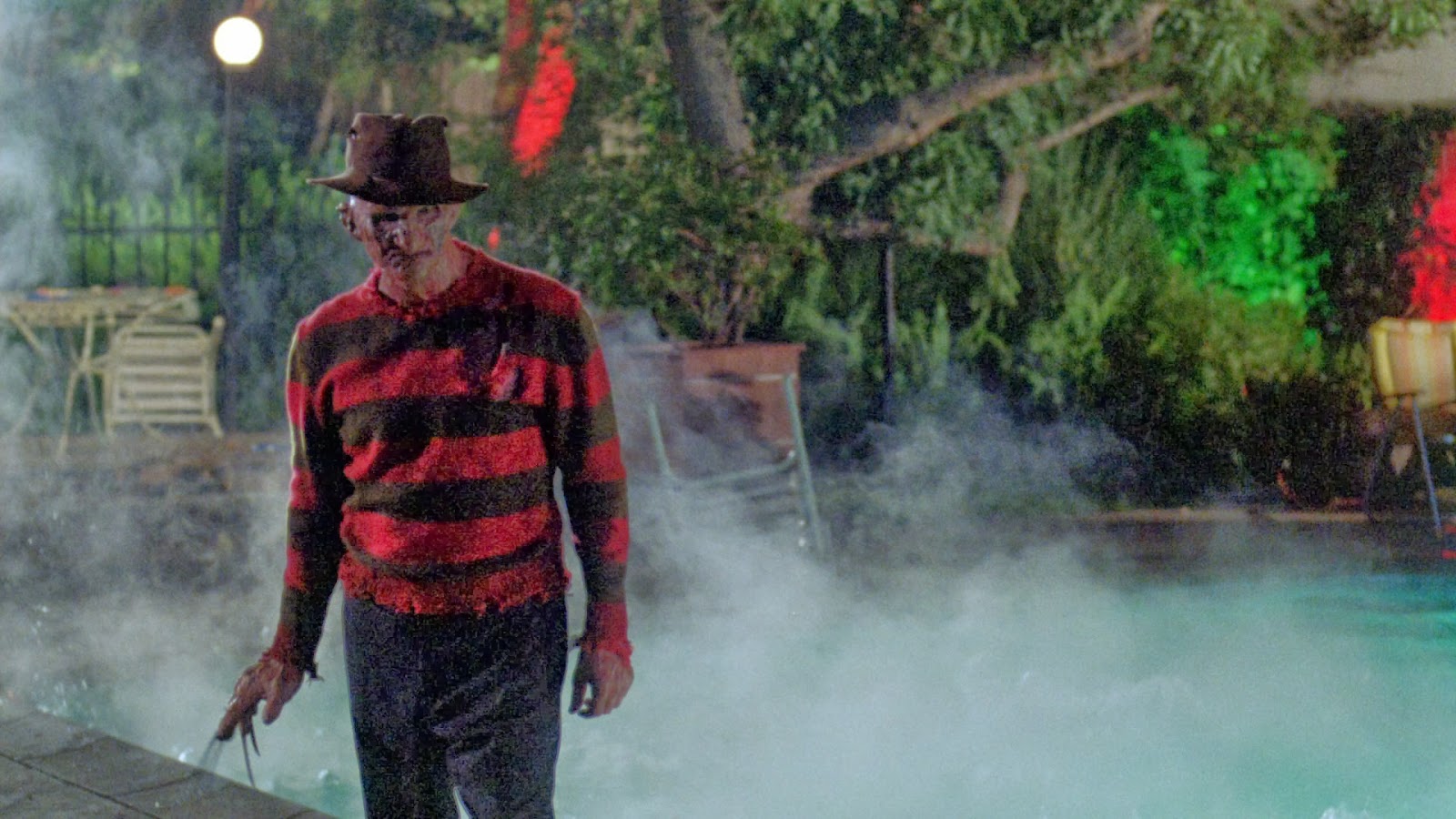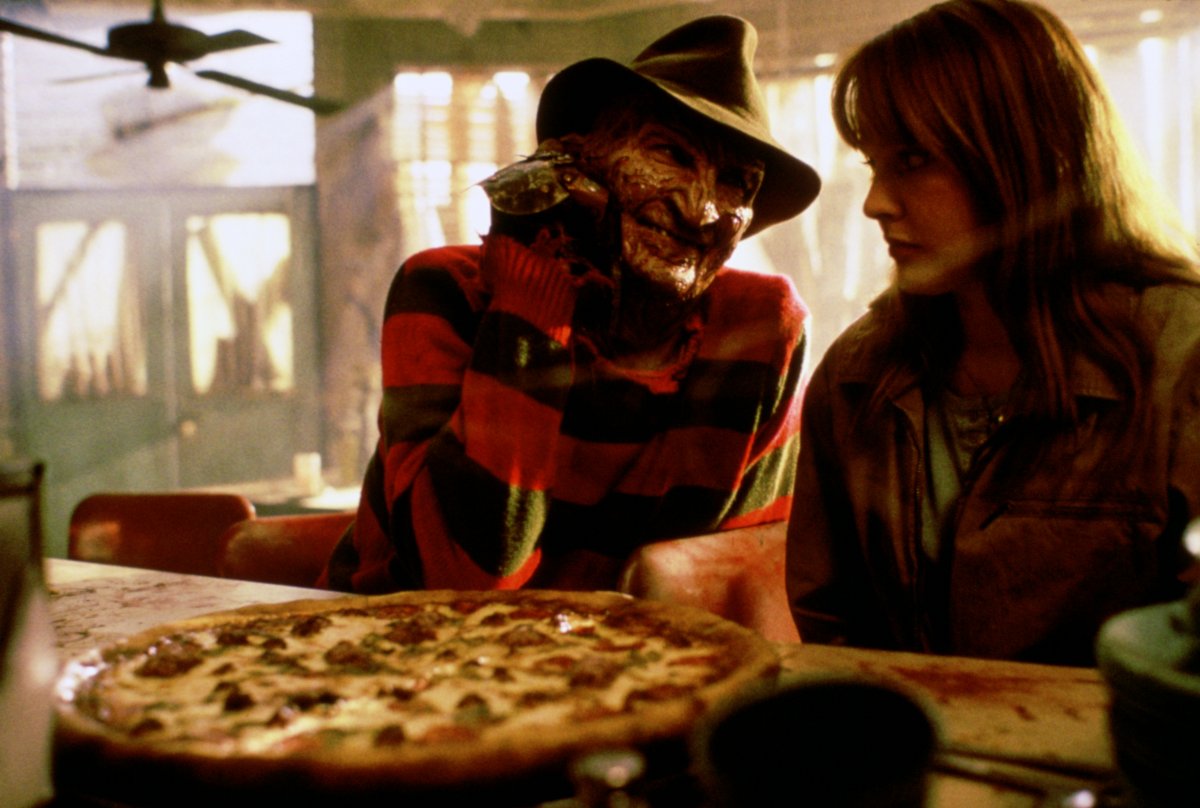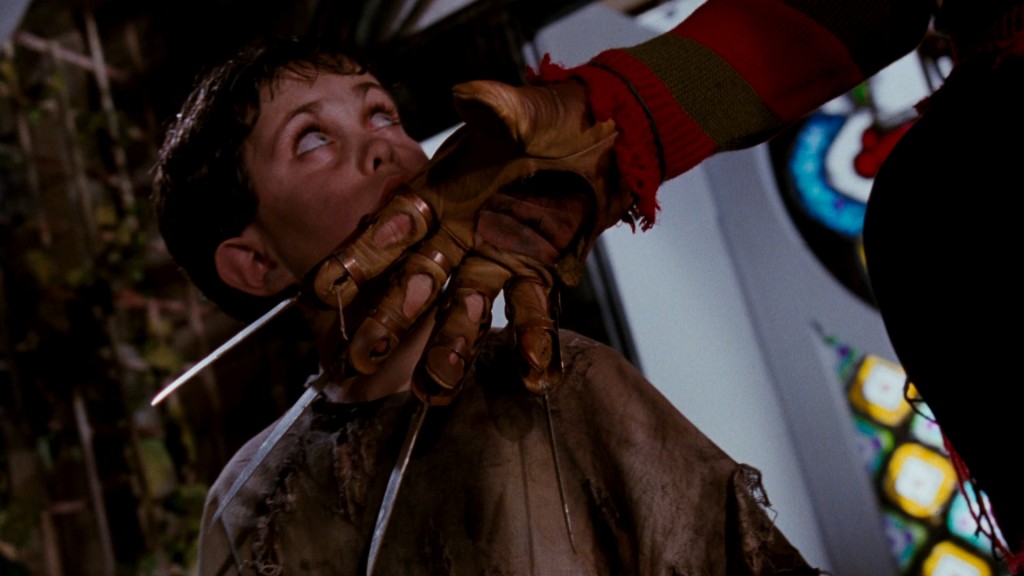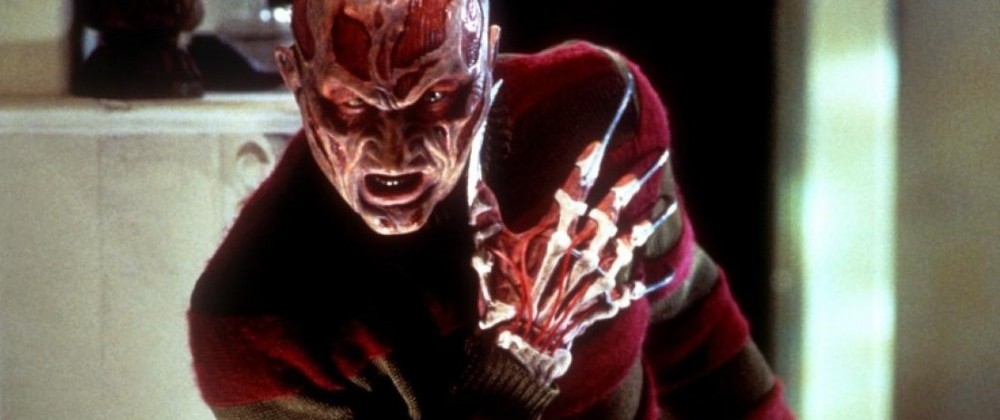A Walk Down Elm Street
by Aaron Pinkston, November 3, 2017
Like all the early horror franchises that started in the late 70s-early 80s, A Nightmare on Elm Street was never intended to be a multi-film franchise—at least by its creators. Wes Craven originally conceived of an ending that was a bit more definitive: Nancy kills Freddy, wakes up to discover the whole incident had been a dream. Whether or not you would have preferred that concept, New Line producer Robert Shaye insisted that the film have a twist ending to keep a franchise possibility open.
By 1984, this was the trend. Halloween and Friday the 13th had both released two massively popular and successful sequels [well, OK, Season of the Witch may not fit that description exactly] by the time Nightmare hit theaters. When the eventual fake out ending was used, Craven decided he didn’t want to be involved with subsequent films.
It would have been amazing to see a Nightmare franchise that was led [or at least had ongoing input] from Craven, but that is an alternate timeline. Based on what we got, this series still stacks up favorably with any other major horror franchise. Sure, there are peaks and valleys throughout the subsequent six films, but the viewing experience on whole is much preferable to the similar journey I took last year when we covered Halloween.
At the end of the day that is solely because of the films’ central character, Freddy Krueger. His strange personality and ability to speak with his victims set him apart from his contemporaries from the very beginning. No matter the rules that were broken or the tones that dramatically changed, Freddy is simply more pliable than Michael or Jason, horror icons that could only be pushed so far because of the simple characteristics that initially made them great.
Personally, I hadn’t revisited many of the Nightmare sequels in many years—not since Freddy vs. Jason was released in 2003—so this was a fun little journey back down Elm Street.
A Nightmare on Elm Street 2: Freddy’s Revenge [Jack Sholder, 1985]
When I was a kid and watched the entire franchise for the first time, Freddy’s Revenge ranked near the bottom for me [and judging by most rankings lists online, that seems to be a common sentiment]. Though the film has the highest body count of the series [thanks mostly to an infamous party scene that takes out a number of unnamed guests], I thought it was pretty boring—it wasn’t scary like the original and yet the full-on silly comic sensibility hadn’t come into play yet. But much of the subtext that has made it a favorite to some went waaaay over my head at the time.
The film takes place soon after the events of A Nightmare on Elm Street when a new family has moved into the Thompson home. A teenage named Jesse [Mark Patton] begins having bad dreams [go figure], though they are a bit different than what we’ve seen before. Freddy, instead of tormenting Jesse to kill is merely tormenting him to take over. Stuck in the dream world, Freddy recruits Jesse to take over his body and continue his kid killing legacy. Having a male at the center of the film was pretty different for the burgeoning teen slasher genre, with “the final girl” becoming the go-to trope, and Jesse’s presence has led to a popular reading of gay subtext. Certainly, scenes like Jesse strutting around his room to the sounds of Fonda Rae’s “Touch Me (All Night Long)” makes it pretty easy to read the subtext.
Given Freddy’s past as a child molester, their dynamic also plays into concepts of “grooming,” which adds an extra layer of creepiness on top of the blood-spattered horror. This definitely makes Freddy’s Revenge ahead of its time and a much more interesting film for the adult me to finally revisit. Approaching the film purely as a horror movie, there is plenty that doesn’t work. But as the franchise grows, Freddy’s Revenge becomes a bizarre turn, inevitably a stand-alone entry and arguably the most interesting sequel of the series.
A Nightmare on Elm Street 3: Dream Warriors [Chuck Russell, 1987]
This is where the tone and style of the Nightmare franchise really took off. Dream Warriors follows a group of troubled kids at a mental health facility where most are being treated for [you guessed it] sleeping disorders. Patricia Arquette plays Kristen, the new starlet of the series, and the one most affected by horrific nightmares—she seems to have some sort of connection to the old Thompson house and the man who haunts it. Heather Langenkamp also returns to the series, now an adult working to help these kids.
The setting makes for a fun environment for Freddy to pick off his victims one by one and certainly serves as a blueprint for the increasingly silly films to come. For better or worse, we start seeing the comical, one may say “creative,” side of the child murderer, including a marionette killing and the beloved TV [“Welcome to primetime”] sequence. The puns start coming, Freddy starts liberally calling his victims “bitch,” it’s all happening. On the other hand, the group dynamic of the “Dream Warriors” is incredibly inventive and adds a lot to the myth and rules of the Nightmare series going forward.
Dream Warriors is the first of another notable trend for the series, giving young filmmakers their first break. This is directed by Chuck Russell, who may not be a household name, but went on to make films such as The Blob [1988], Jim Carrey's The Mask, Eraser, and The Scorpion King. He may have been tapped to direct the nightmare horror flick for his work as screenwriter of another nightmare-influence film, Dreamscape, which covers much of the similar interest in psychoanalyzing dreams as in Dream Warriors. Overall, Dream Warriors may have influenced the worst traits of the oncoming series, but the great young cast and fun setting creates a supremely entertaining mid-80s horror film.
A Nightmare on Elm Street 4: The Dream Master [Renny Harlin, 1988]
The Dream Master opens with Kristen [now played by Patricia Arquette pseudo-lookalike Tuesday Knight] pulling her Dream Warrior compadres into a dream back at the old Thompson house. Though they buried Freddy in the previous film, Kristen is sure that their tormentor is coming back—and, of course, he does, easily taking out Kincaid and Joey in the first few scenes. This opening is both an audience fake out and an opportunity to pass the curse on to another group of teenagers, led by Alice [Lisa Wilcox], a shy and homely girl who was a friend of Kristen—a nightmare sequence literally passes over Kristen’s strange power over to Alice.
Aside from Alice, who is a very sympathetic character and good “final girl” lead, this new batch isn’t particularly interesting. Luckily, the Freddy factor is turned up to 11, with some of the craziest kills of the franchise and some classic one-liners [the “Wanna suck face?” sequence isn’t a particularly memorable effect, but that line is a doozy]. Alice entering a movie theater screening is one of the most inventive scenes, especially since it includes the very fun “soul food” pizza gag. And the final showdown is actually pretty creepy in a franchise that quickly became devoid of genuine scares. Freddy’s death at the end of The Dream Master is an incredibly effective special effect, the souls of Freddy’s victims rejecting their host body and destroying the monster from the inside. The Dream Master is middle-of-the-road Nightmare series without much of a hook but with a few of its highest points.
A Nightmare on Elm Street 5: The Dream Child [Stephen Hopkins, 1989]
The Dream Child is all about the myth building of Freddy Krueger's origins. Many of the early dream sequences of the film center around Alice observing the life of Amanda Krueger, the nun we learned about in Dream Warriors who was believed to be violently raped by psychopaths with Freddy as the offspring result. These sequences are beautifully staged, if a bit self-serious, and seeing a little baby Freddy scurrying around is a bit silly. As a movie monster origin, though, it is relatively successful. These days, the studio would be more willing to take a clean break for the origin story, but The Dream Child thankfully isn’t that—after this first act, the film becomes a tried-and-true Nightmare film in the vein of the two films that came before it.
We shift to another group of mildly annoying teenagers [now recent high school graduates] with a tenuous connection to our new leading girl and then revel with glee as they are picked off one-by-one in new heights of equally creative and silly deaths. OK, the deaths in The Dream Child are a bit closer to the silly side. The “highlights” are the death-by-gorging upscale dinner party [one of my favorites in memory but it doesn’t quite hold up despite the gruesome effects] and the death-by-comics sequences [perhaps inspired by the “Take On Me” music video]. But it is the battle between Alice and Freddy over her unborn child that really gets strange.
The film gets real dramatic, almost into after-school special territory, on whether Alice should keep the baby, let the father’s folks adopt him, and even addresses the option of abortion. But as Alice lives through the unborn child’s subconscious dreams, she sees him as a child [played by Whit Hertford, aka the kid that Sam Neill scares with the raptor claw at the beginning of Jurassic Park] and develops a motherly bond to protect him against Freddy. It is a weird metaphor for parenting a child and actually plays surprisingly well with the backdrop of Freddy’s own upbringing.
Freddy’s Dead: The Final Nightmare [Rachel Talalay, 1991]
The Nightmare on Elm Street series came to an end [wink] with the delightfully titled Freddy’s Dead: The Final Nightmare. Despite the continued box office success of the series [The Dream Child did about half the business of the extraordinarily successful The Dream Master, but also had half the budget], it was pretty easy to see that the franchise had jumped the shark. The tide had begun turning all the way back in Freddy’s Revenge and by now this is much more a comedy than a horror film.
Just how far Freddy’s Dead goes into this direction is stark, however, most easily seen in how it handles its horror icon. Freddy gets much more time to vamp in Freddy’s Dead. Not only does it seem that the character gets more screen time, but the film seems to light him more like any other character who doesn’t happen to be a movie monster more effective in the shadows. Even his iconic makeup seems to have changed for Freddy’s Dead to look softer and less grotesque.
I may seem to be critical of this “finale” but the changes in tone has some positive effects, too—as far as giant horror franchises go, this supposed ending fares much better than the dreck in Halloween, Hellraiser, Friday the 13th, and so on. Freddy may be goofier, but the film’s set-up is rather interesting: expanding on the mythology that has seeped through the series, we find out that before becoming the supernatural killer Freddy had a baby, who of course needs to reckon with daddy before his reign can end. Freddy’s Dead is primarily set in a safehouse for troubled teenagers who serves as this film’s Freddy fodder. The kills have become particularly memorable, mostly for worse, especially a video game setpiece where Freddy torments his victim with a play on Nintendo’s “power glove.”
Rachel Talalay, now best known for her extensive work on TV and the cult film Tank Girl, worked on the Nightmare series in various production roles from the beginning before finally getting the nod to direct. No matter what you think of Freddy’s Dead, her position is notable as women directors have been completely absent in horror franchise films [with a quick bit of research, I couldn’t find any].
Wes Craven’s New Nightmare [Wes Craven, 1994]
The second best film of the franchise, there was a time when I considered New Nightmare my favorite. Revisiting both films recently, it is clear that the original Nightmare holds up far better, but New Nightmare is an extraordinarily creative take on bringing Freddy back.
The premise of the film is very meta: 10 years after the release of A Nightmare on Elm Street, actress Heather Langenkamp begins having bad dreams while Wes Craven starts working on a mysterious new script. Langenkamp is resistant when offered to reprise her most famous role as she’s put horror films behind her after the birth of her son [Miko Hughes, who, between this and Pet Sematary is the creepiest child actor of all time]. New Nightmare uses its meta nature to be super insidery, with roles for New Line head Robert Shaye, producer Sara Risher, Robert Englund with and without the makeup, John Saxon, and cameos by a number of other Nightmare alums [unfortunately, no Roseanne and Tom, who made a strange appearance in Freddy’s Dead]. As Freddy continues to haunt Langenkamp and her family, the film constantly references the original film with visual cues and remakes of some of its kills.
What is absolutely different about New Nightmare, however, is Freddy. His look is completely revamped, especially considering how we last saw him in Freddy’s Dead. To match the darker tone of the film, Freddy is scarier than previously in both look and attitude, more demonically inspired than the quick-witted trickster in the later sequels. He is no longer the fun monster in a movie but a real and dangerous threat.
Made two years earlier, this is sort of like a meta dry run for Craven’s more popular film Scream. It isn’t quite as polished, it definitely feels like a high concept plot film, but that concept is brilliant. New Line could have use any excuse to bring back their money maker, including just ignoring the fact that they “killed” him off in the last film. Instead, they gave the reins back to the original creator and let him run with an idea that is so original it really has no place in a mainstream horror franchise.
Now you'll notice I'm stopping here without talking about Freddy vs. Jason and the 2010 remake. To me, though I have plenty of reverence for the fan service film that brought the two horror icons together, Freddy vs. Jason is a Friday the 13th movie that has Freddy in a supporting role. As for the remake ... naaaaah.







